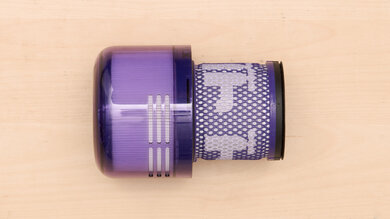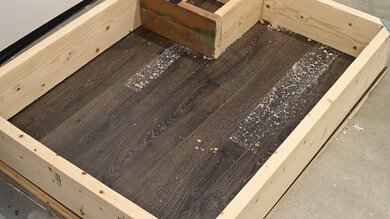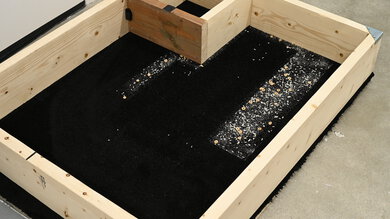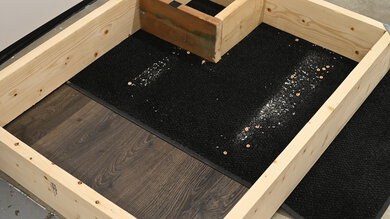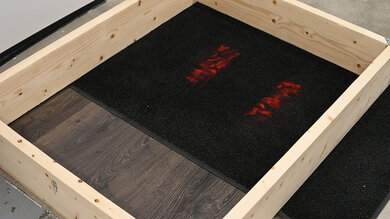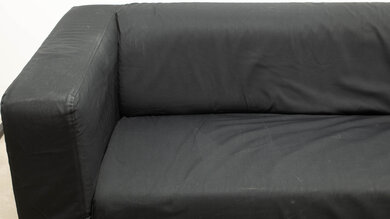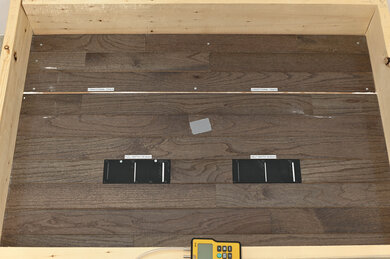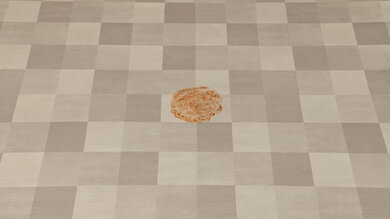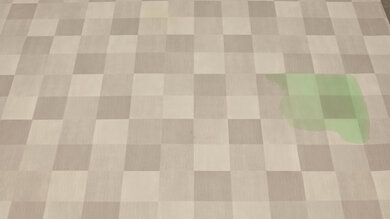The Dyson V11 is a cordless stick/handheld vacuum. It sits in the upper mid-range of Dyson's extensive lineup of V-series cordless stick vacuums, above the less powerful and older Dyson Cyclone V10 and the Dyson V8, but slightly below the newer, more powerful Dyson V15 Detect and the Dyson Gen5detect. The V11 offers strong performance on a variety of surface types and features a surface detection system that enables it to automatically change its suction power mode to suit different floor types. However, it foregoes the particle sensor found in more recently released models.
Our Verdict
The Dyson V11 is good for bare floors. It does a good job of clearing away a mix of debris types on hard surfaces. Although its build quality is just okay, with plastic components that feel a bit fragile, it's fairly easy to maintain. It also does a decent job of handling debris in cracks and crevices, like grout lines on a tile floor.
-
Great performance on most floor types.
-
Virtually no recurring costs.
-
Fairly easy to maintain.
-
Automatic power adjustment capability.
-
Plastic design feels fragile.
-
No mopping attachment for stains.
The Dyson V11 is very good for cleaning low-pile carpets. It offers consistently strong performance on this surface type, even if you might need to make an extra pass to clear away every last bit of debris. However, while it's easy to take apart and reassemble, its build quality is only okay, with somewhat fragile plastic construction. It can also easily get caught on lightweight tasseled rugs, forcing you to turn the vacuum off to free it.
-
Great performance on most floor types.
-
Virtually no recurring costs.
-
Fairly easy to maintain.
-
Automatic power adjustment capability.
-
Plastic design feels fragile.
-
Can get stuck on lightweight tasseled rugs.
The Dyson V11 is very good for cleaning high-pile carpets. It offers strong overall performance on this surface type, clearing away a mix of debris types within a single back-and-forth pass, though you might need to go over the same area again to collect everything. Unfortunately, it's a little heavy for a cordless stick vacuum, making it a hassle to maneuver.
-
Great performance on most floor types.
-
Virtually no recurring costs.
-
Fairly easy to maintain.
-
Automatic power adjustment capability.
-
Plastic design feels fragile.
The Dyson V11 is excellent for cleaning pet hair. It does an outstanding job of picking up pet hairs on any surface type. Its brushroll is also easily removable, making cutting away any tangled hair a little easier. Its six-stage filtration system is also pretty effective in sealing in fine allergens like pet dander. It isn't unusually noisy either, which is good if your pet is sensitive to loud sounds. However, there's no dedicated pet-grooming tool or a mopping attachment to deal with dried-on stains, like mud or dirt your pet might track in.
-
Virtually no recurring costs.
-
Removable brushroll.
-
Six-stage filtration system.
-
Superb pet hair cleaning capability.
-
No pet grooming brush.
-
No mopping attachment for stains.
The Dyson V11 is excellent for cleaning stairs. It's portable, if somewhat heavy for a stick vacuum, and its cordless design means you don't have to worry about tripping over a power cord while climbing and descending staircases. While it performs well on all surface types, its plasticky body is a little fragile in places and could be damaged if you drop it.
-
Great performance on most floor types.
-
Good overall maneuverability.
-
Automatic power adjustment capability.
-
Plastic design feels fragile.
-
Can feel a bit heavy in the hand after a while.
The Dyson V11 is great for cars. It's portable, though it can feel a little heavy in your hand when used for extended periods. Since it doesn't have a cord, you don't need to stay close to an electrical outlet or fiddle with an extension cord while cleaning your car. You can also reconfigure it as a handheld vacuum, and it comes with a crevice tool so you can get to those hard-to-clean places.
-
Great performance on most floor types.
-
Good overall maneuverability.
-
Can feel a bit heavy in the hand after a while.
The Dyson V11 isn't designed for workshop cleaning. It can't deal with liquid spills, and heavier debris like metal shavings could damage its cyclone and filters.
-
Great performance on most floor types.
-
No mopping attachment for stains.
-
You can't use it to deal with liquid spills.
- 7.6 Bare Floor
- 7.9 Low-Pile Carpet
- 7.6 High-Pile Carpet
- 7.8 Pets
- 8.6 Stairs
- 8.2 Cars
- 5.6 Workshop
Changelog
-
Updated Jan 31, 2025:
Minor in-text adjustments to improve readability and better convey product details. Added Extra and Absolute Extra variants.
-
Updated Nov 29, 2024:
We've added a link to the Shark PowerDetect Cordless in the Hard Floor Pick-Up section of the review to provide an alternative that delivers superior debris pickup on bare surfaces.
-
Updated Nov 15, 2024:
Added the Miele Duoflex HX1 as an alternative that's better built in the Build Quality section.
-
Updated Oct 29, 2024:
We've added a link to the RYOBI PCL720K in the Build Quality section of the review to provide a more sturdily-built alternative.
- Updated Aug 26, 2024: We've updated the scores in the Hard Floor Pick-Up, High-Pile Carpet Pick-Up, Low-Pile Carpet Pick-Up, and Pet-Hair Pick-Up tests to align with a broader data set. For more information about the reasoning for this update, you can look at our forum post.
Check Price
Differences Between Sizes And Variants
The variants of the Dyson V11 differ only in color and in the included attachments. We tested the Animal model.
| Model Name | Tools Included | Color | Notes |
|---|---|---|---|
| V11 Origin | Motorbar floorhead, hair screw tool, crevice tool, soft bristle brush | Nickel/Blue | |
| V11 Extra | Motorbar floorhead, stiff bristle brush, combination tool, crevice tool, mini soft dusting brush, hair screw tool, fabric and mattress tool, up-top adaptor | Iron/Purple, Red/Purple | |
| V11 Animal | Torque Drive floorhead, mini turbo brush, combination tool, crevice tool, stiff bristle brush | Nickel/Purple | |
| V11 Plus | Motorbar floorhead, combination tool, crevice tool, soft bristle brush, fabric and mattress tool, low-reach adaptor, mini turbo brush | Purple/Nickel | |
| V11 Torque Drive | Torque Drive floorhead, mini turbo brush, combination tool, crevice tool, soft-bristle brush, stiff bristle brush | Nickel/Copper, Nickel/Blue | Has an LED screen that displays the remaining runtime in real time |
| V11 Absolute | Torque Drive floorhead, soft roller floorhead, mini turbo brush, combination tool, crevice tool, soft-bristle brush, stiff bristle brush | Nickel/Copper, Nickel/Blue | Not available in the US market |
| V11 Absolute Extra | Torque Drive floorhead, combination tool, crevice tool, mini motorized tool, soft dusting brush, stiff bristle brush, extension hose, flexi-crevice tool, up-top adaptor | Nickel/Red | Not available in the US market |
If you find another variant of this vacuum, please let us know in the comments and we'll update our review.
Compared To Other Vacuums
The Dyson V11 is a cordless stick vacuum. It's heavier than the older Dyson V8 but compensates with better performance across most surfaces, a longer battery life, and an automatic power adjustment feature. However, it lags behind newer, pricier Dyson models like the Dyson V15 Detect or the Dyson Gen5detect regarding raw suction power.
If you want to see more options, check out our lists of the best cordless vacuums, the best hardwood vacuums, and the best lightweight vacuums.
The Dyson V11 is better overall than the Dyson V8. It offers superior performance on most surface types thanks to its more powerful suction motor, higher-capacity battery, larger dustbin, and automatic power adjustment system. That said, the V8 is lighter.
The Dyson V15 Detect is a better vacuum than the Dyson V11. They're similar in build quality, battery performance, and maneuverability, but the V15 is a little lighter, delivers superior cleaning performance on all surface types, and has a built-in particle sensor. Conversely, the V11 is less demanding in terms of maintenance requirements.
The Dyson V11 is a little more versatile than the Dyson Outsize. The V11 is easier to maintain and maneuver, is slightly more portable, and delivers superior performance on low-pile carpets. Meanwhile, the Outsize has a larger dirt compartment that doesn't need to be emptied as often and has a longer total runtime thanks to its extra battery. It also comes with a larger selection of tools and accessories.
The Dyson V11 outclasses the Dyson V7. The V11 has a far more powerful motor, a larger dustbin, and a higher-capacity battery that allows for longer runtime. That said, the V7 is a little lighter.
The Dyson V12 Detect Slim is a little better than the Dyson V11, though they each have advantages. The V12 performs better on bare floors with its soft roller head, clears more pet hair on upholstered surfaces, charges faster while offering similar battery life, and has a lighter construction that's easier to maneuver. Its particle counter could also be handy if you suffer from allergies and want to know about the concentration of fine particles in your home. However, the V11 does a better job cleaning low-pile carpeting and features a larger dustbin that won't need emptying as often.
The Dyson V11 and the Samsung Jet 75 each have their strengths, meaning one might suit you better than the other, depending on your needs. The Dyson lasts slightly longer on a single battery, comes with a wider assortment of attachments, has a telescopic wand, and has an automatic power adjustment feature that lets it increase its suction power to match the surface you're cleaning. Conversely, the Samsung feels sturdier, performs better on high-pile carpets, and is fully compatible with a self-emptying base station, which is somewhat pricey and does incur high recurring costs but also makes it even easier to maintain. Pricier variants of the Samsung also come with two batteries, giving it a longer overall runtime.
The Samsung Jet 90 Complete and the Dyson V11 are similar vacuums, but the Dyson is better for most uses. The Dyson deals with debris more effectively on bare floors and carpets, though the Samsung is compatible with a specialized mopping attachment.
The Dyson V11 is better than the Samsung Jet 60, though the Samsung is a good alternative for the price. The Dyson is a little easier to maintain, incurs virtually no recurring costs, has a telescopic wand, lasts longer on a single charge, does a better job dealing with pet hair on upholstery, and performs better on bare floors and low-pile carpets. However, the Samsung charges much faster, weighs considerably less, and makes slightly less noise.
The Dyson V11 is better than the Samsung Bespoke Jet. The Samsung feels better built, weighs less, comes with two batteries that can be charged at once, giving it a longer overall runtime, and delivers better overall performance on all surface types. Its Cleaning Station accessory allows you to quickly empty its dustbin without creating a plume of dust. That said, the Dyson pulls ahead where it counts, delivering superior debris pickup performance on bare floors as well as low-pile carpets.
The Dyson V11 is a better vacuum than the Dyson Omni-glide. The V11 delivers excellent performance on bare floors and does a very good job on carpets. It comes with a bigger variety of tools and brushes, and its dirt compartment can hold more debris. On the other hand, the Omni-glide is much lighter and recharges more quickly, although its performance on bare floors is mediocre.
The Dyson V11 and the Shark Vertex Pro Lightweight each have their advantages, meaning that one may suit you better than the other, depending on your needs. The Dyson has fewer parts that require regular maintenance, has a rack station and an onboard tool clip, and has a motorized turbo brush. It also does a better job of clearing debris on low-pile carpets. Conversely, the Shark performs better on bare floors and high-pile carpets, is a little easier to maneuver thanks to its flexible wand, feels more sturdily built, has a larger dustbin, and charges faster while offering similar overall battery life.
The Dyson V11 and the Shark Vertex Lightweight Cordless are fairly evenly matched overall, and you may prefer one over the other depending on your needs. The Dyson is easier to maintain, has a longer maximum battery life, and performs better on low- and high-pile carpets. Meanwhile, the Shark feels better made, is more maneuverable, and cleans more debris on bare floors. It also charges substantially faster.
The Dyson V11 is ultimately better than the Dyson Cyclone V10. The V11 has an automatic power adjustment system as well as a more powerful suction motor, though this doesn't necessarily correlate to a drastic improvement in real-world performance.
The Dyson V11 and the LG CordZero A9 each have their advantages, so one may suit you better than the other, depending on your needs. The Dyson has fewer parts that require regular maintenance, incurs virtually no recurring costs, has a larger dustbin, and has a surface-type adjustment feature. It also performs better on bare floors and high-pile carpets. Conversely, the LG weighs less, and you can buy a bundle with a second battery that effectively doubles its runtime.
The Dyson V11 is a better vacuum than the Tineco PURE ONE S11. The Dyson is more effective for picking up debris on hard floors and carpeted surfaces. However, the Tineco is a superior option for quick cleaning sessions, as it weighs considerably less and is a little bit quieter. Conversely, the Dyson is heavier but has a more potent suction motor that allows for better debris-pickup performance on carpets.
The Miele Triflex HX1 is superior to the Dyson V11. The Miele feels better made, is easier to maintain, and performs better on bare floors and low-pile carpets. It also feels lighter in your hand and is more maneuverable. Conversely, the Dyson has a longer maximum battery life, more tools and brushes, a bigger dirt compartment, and slightly better performance on high-pile carpets.
The Dyson Ball Animal 2 Total Clean/Origin is a better vacuum for cleaning floors, while the Dyson V11 is more versatile. The Ball Animal 2 is an upright vacuum with outstanding performance on bare floors and carpets. It also has a bigger dirt compartment and a pet grooming tool. The V11 is a cordless stick vacuum, so you're not limited by a cord in terms of its range. You can also use it as a handheld vacuum, which is helpful for vacuuming stairs or inside cars.
The Dyson V11 is better than the Roborock H7. The Dyson feels slightly more robust, has fewer parts needing periodic cleaning, has a removable battery, delivers better performance on low-pile carpets, and does a better job clearing debris in cracks thanks to its stronger suction force. Meanwhile, the Roborock is lighter, has a longer battery life, and can be used as a bagged vacuum, making it easier to dispose of any accumulated debris.
The Dyson V11 is a better overall vacuum than the Shark Rocket Corded. The Dyson stores easier, has a bigger dirt compartment, and is cordless, so you can go anywhere with it. It can also adjust its power level to better suit the mess, and it comes with several tools that help to clean more specific objects like blinds, which is nice. On the other hand, the Shark is corded, so you never have to worry about running out of battery life or recharging it.
The Dyson V11 is better than the Shark ION F80 Cord-Free MultiFLEX for most uses. It performs better on carpet, as it sucks up a decent amount of debris on both low-pile and high-pile carpets. This means it's also better suited to clean cars and comes with more tools. The Shark has a wand that can bend 90 degrees so it has better maneuverability, and the batteries on the Shark are also better.
The Dyson V11 is better overall than the Roborock H6 Adapt, though they perform similarly. While the Roborock is more effective on high-pile carpets, the Dyson is slightly better on low-pile carpets and bare floors, particularly at picking up bulky debris like cereal. They're both easy to maneuver and reconfigure into handheld vacuums. The Dyson is slightly less portable but has a slightly larger dirt compartment. On the other hand, the Roborock has better overall battery life.
The Dyson V11 and the Shark PowerDetect Cordless each have their own advantages. While the Shark feels better built, the Dyson is noticeably lighter and easier to pick up and carry as a result. The Dyson also delivers better performance on carpeted floors, and it recharges a lot faster while providing similar battery life. Meanwhile, the Shark is a little more efficient on bare flooring, and its folding wand makes it easier to clean under furniture. Unlike the Dyson, it's also fully compatible with a self-empty base station.
The Miele Duoflex HX1 and the Dyson V11 have different strengths. The Dyson offers superior performance on every surface type and has a larger dust container, so you'll have to empty it less frequently. Unlike the Miele, there are also no recurring costs. That said, the Miele is much better built, offers superior battery life, and depending on the variant, can be more versatile thanks to the inclusion of an extension hose and extendable, flexible crevice tool.
The Dyson V11 is better than the Shark Cordless Pet Plus. The Dyson takes up less room, has a much longer battery life, has a wider array of attachments, has a substantially more powerful suction motor, and is easier to maneuver. However, the Shark has a higher-capacity dustbin and feels a little bit sturdier.
The Samsung Jet 70 is better than the Dyson V11. The Samsung is notably lighter, charges much faster, makes a little less noise, and delivers better performance on bare floors as well as low- and high-pile carpets. However, the Dyson has a surface detection system that allows it to automatically increase its suction power depending on the floor type that you're on. It also has a longer battery life and is more effective in dealing with pet hair on upholstered furniture.
The Dyson V11 is better than the Tineco PURE ONE X for most uses. The Dyson has less demanding maintenance requirements, incurs virtually no recurring costs, has a bigger dustbin, is easier to maneuver, and performs notably better on low- and high-pile carpets. Conversely, the Tineco is lighter, charges faster, and clears more debris on bare floors.
The Dyson V11 is better than the Wyze Cordless Vacuum for most uses, though the Wyze is still a good budget-friendly option. The Dyson has a more powerful motor, an automatic power adjustment system, a bigger dustbin, and a longer battery life. Meanwhile, the Wyze is notably lighter, and its less powerful motor makes it easier to maneuver on really plush carpets.
The Dyson V11 is ultimately a stronger performer than the RYOBI 18V ONE+ PCL720K. The Dyson delivers much better debris-pickup performance across a variety of surfaces, and it's packed with a wider array of features. Its surface detection system allows it to automatically change its suction power setting depending on the surface you're cleaning, and its multi-stage filtration system does a much better job of locking in particles compared to the RYOBI. The Dyson is also lighter and quieter and can be bundled with more tools. On the other hand, the RYOBI feels considerably more solidly built.
The Dyson V11 and the Shark Vertex Pro Powered Lift-Away are cordless vacuums that are differently designed, meaning one might suit you better, depending on your needs. The Dyson is a stick vacuum that has fewer parts needing regular cleaning, is easier to store, and weighs less. Meanwhile, the Shark is a cordless upright that delivers better performance on all surface types, does a better job dealing with debris in cracks, feels lighter in your hand, charges faster, and has a larger dirt compartment.
The Dyson V11 is better overall than the Dyson Micro 1.5kg. The Micro is lighter and more portable, but it's not suited for carpets, so it's less versatile. Meanwhile, the V11 has a larger dirt compartment and longer maximum battery life, and though it's not quite as effective as the Micro on bare floors, it still does an excellent job on this surface type.
The Shark Rocket Pet Pro and the Dyson V11 are similarly performing stick/handheld vacuums. The Shark feels better built, it's significantly more maneuverable, and it has a better performance on bare floors and low-pile carpets. The Dyson, on the other hand, is easier to maintain, has a bigger dirt compartment, and more tools. It also has better performance on high-pile carpets.
The Shark APEX UpLight and the Dyson V11 are similar stick vacuums. The Shark has better performance on bare floors and low-pile carpets, while the Dyson is slightly better on high-pile carpets. The Shark has a better build quality, and the Dyson is more versatile as it's a cordless vacuum, but that means you have to worry about its battery life, which doesn't last very long on the max power settings.
Test Results
This vacuum's build quality is just okay. It looks very similar to other Dyson models like the Dyson V15 Detect and has a fairly premium appearance. However, aside from the lightweight metal wand, it's almost entirely made of plastic that doesn't feel extremely sturdy. Parts made of clear plastic feel particularly fragile and could shatter if you drop them or knock against something hard. If you're searching for something more sturdily built, the RYOBI PCL720K is a good choice. Alternatively, for a more premium option consider the Miele Duoflex HX1.
On the upside, the controls are easily accessible on top of the vacuum. There's also a grippy rubber strip near the top of the handle, which helps prevent it from sliding and falling over when you lean it against a wall. An indicator light on the vacuum's body will turn on if there's a blockage or if a filter isn't seated correctly in its housing.
Out-of-the-box assembly is quick and easy, and it has a button you can push to quickly unclip a tool or brush.
This is an easy vacuum to maintain. Not many parts need regular cleaning, and these parts are easy to access.
The wand needs to be removed to access the detachable dirt compartment. You might find this inconvenient, as some comparable handheld cordless stick vacuums allow the dirt compartment to be removed with no disassembly. From there though, the dirt compartment can be emptied into a garbage can and wiped down with a damp cloth if necessary.
The HEPA filter is easy to remove. It sits right on top of the vacuum body and twists off easily. It should be washed once a month or when the filter indicator lights up. Let it dry completely before reinserting it into the vacuum.
Remove dust and debris from the lint screen when needed.
Hair wrapped around the main brushroll must be removed occasionally. This is difficult to do by hand because the hair can get wrapped around the roll very tightly. It's much easier to do with scissors.
The Dyson V11 has no recurring costs, like most bagless vacuums. The filter is permanent and should last the vacuum's life if cleaned according to the manufacturer's recommendations. If it ever needs to be replaced, you can find it on Dyson's website along with other replacement parts.
The Dyson V11 comes with a wand-mounted tool clip which can store two of the included tools while you use the vacuum. The wall mounted docking station can store two more tools.
The Dyson V11 has an adequately sized dirt compartment. It uses the same overall design as the Dyson V15 Detect. Its horizontal orientation makes it easy to empty, but it isn't the largest dustbin on the market. If you want a Dyson stick vacuum with a larger dustbin and don't mind using something bigger and more unwieldy, the Dyson Outsize is a solid alternative.
Since it's a cordless vacuum, its range is limited only by the remaining battery life and the room left within its dustbin.
This vacuum is pretty portable. While it feels heavier in the hand than most cordless stick vacuums we've tested, including alternatives like the LG CordZero A9, it's still substantially lighter than most traditional corded upright vacuums.
This vacuum's battery performance is okay. If you use it in its handheld configuration in the 'Eco' setting, it can provide well over an hour of continuous use, which is quite long by the standards of other cordless stick vacuums. However, the battery can be depleted in less than 10 minutes when used as a stick vacuum in 'Boost' mode, so you need to work quickly when cleaning stubborn messes. The runtime in its default 'Auto' mode can vary pretty drastically between extremes since the vacuum will automatically adjust its suction power depending on the surface you're cleaning.
A trio of LCD segments on the Animal variant shows you an estimate of the battery's charge status. However, you'll have to step up to the pricier Torque Drive model if you want a more informative LCD display that shows a real-time countdown of remaining runtime, which is very similar to the screen found on the Dyson V15 Detect or the Dyson Gen5detect.
Unfortunately, this vacuum doesn't have a second battery that you can charge and swap in to extend its overall runtime. If you don't want to worry about battery life, check out a corded stick/handheld vacuum like the Shark Rocket Corded.
This vacuum has a few features to make your cleaning experience easier. Like the Dyson V15 Detect, using it in its 'Auto' power model allows it to adjust its power level automatically to match the surface you're cleaning. There are also manually selectable 'Eco' and 'Boost' modes for conserving power when dealing with lightweight debris or stubborn messes, respectively.
You can also adjust the main vacuum head's suction to accommodate different surface types, but you have to do it manually via a small slider on the head. Unlike the Wyze Cordless Vacuum, its main floorhead doesn't have a headlight to help you see into darker areas.
The Animal variant of the Dyson V11 comes with a few different tools and brushes to help you get the job done. Its upholstery tool also has a slide-on soft-bristle brush, so you can use it for cleaning fabric surfaces or dealing with lightweight debris on delicate surfaces. There's also a miniature turbo brush tool that you can use to clean furniture or stairs, not to mention a crevice tool for dealing with debris in tight spots, and a hard-bristle brush for more stubborn messes. Although there isn't technically an extension wand, you can attach any tool to the end of the main wand for added reach.
This vacuum delivers good performance on hard floors when paired with its Torque Drive multi-surface floorhead. It's quite effective at clearing away fine debris. It also does a good job of dealing with medium- and large-sized debris, but it tends to push a small amount of this kind of debris around rather than removing it. If you want a cordless vacuum that performs a little better on this surface type, look at the Shark PowerDetect Cordless or the Shark Stratos Cordless.
This vacuum has good suction power. The manufacturer advertises the suction motor as offering 185 AW of suction power while the newer Dyson V15 Detect produces a maximum of 230 AW of power. The V15 that we tested was also fitted with a fluffy floorhead, which generates a tighter seal against flat surfaces compared to this V11's multi-surface head.
The Dyson V11 has decent airflow performance. It's a little ways off of the newer, class-leading Dyson Gen5detect in this respect, but still far from a slouch, especially for a cordless vacuum. It's powerful enough to suck up most kinds of large and heavy debris without too much effort.
This vacuum is impressively quiet. It makes a slightly less high-pitched noise than the Dyson V8, which won't be especially noticeable if you run the vacuum in an enclosed room.
This vacuum has good maneuverability. Used in its stick configuration, it feels a little heavy in your hand, but its relatively sleek design and smoothly rotating floorhead make it easy to pivot around obstructions. However, the top of the handle with the tool attachment points is a bit bulky, so you need to crouch down to clean under low furniture like couches and coffee tables. The handheld configuration makes it very easy to clean furniture. However, unlike the Miele Triflex HX1, it has no automatic brushroll shutoff feature, so it can easily get stuck on hazards like rug tassels. Thankfully, you won't have any issues on a thicker rug or around cables.
The Dyson V11, like most of Dyson's other vacuums, is equipped with a HEPA filter that ensures good air filtration performance. No visible fine particles escape in our test.
The Dyson V11 does a decent job cleaning debris in cracks and crevices. When used in its 'Auto' power mode with its floorhead's suction gate left open, it easily clears away debris in shallower cracks, but some can still be left behind in deeper crevices. If you want the best crevice-cleaning performance, run the vacuum in its most powerful 'Boost' mode with its crevice tool. Alternatively, consider purchasing a compatible fluffy brushroll for improved debris pickup on hard floors and in crevices.
Comments
Dyson V11: Main Discussion
Let us know why you want us to review the product here, or encourage others to vote for this product.
This product has been merged with Dyson V11 Torque Drive+ Cordless Vacuum Cleaner. Follow the discussion here.




